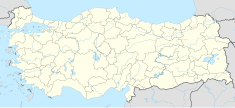
Anatolia, also known as Asia Minor, is a peninsula of Turkey situated in Western Asia. It is the westernmost protrusion of the Asian continent, and constitutes the majority of contemporary territory of Turkey. Geographically, Anatolia is bounded by the Mediterranean Sea to the south, the Aegean Sea to the west, the Turkish Straits to the northwest, and the Black Sea to the north. The eastern and southeastern limits has either been expanded to the entirety of Asiatic Turkey, or to an imprecise line from the Black Sea to Gulf of Iskenderun. Topographically, the Sea of Marmara connects the Black Sea with the Aegean Sea through the Bosporus strait and the Dardanelles strait, and separates Anatolia from Thrace in the Balkan peninsula of Southeastern Europe.

Hatay Province is the southernmost province and metropolitan municipality of Turkey. Its area is 5,524 km2, and its population is 1,686,043 (2022). It is situated mostly outside Anatolia, along the eastern coast of the Levantine Sea. The province borders Syria to its south and east, the Turkish province of Adana to the northwest, Osmaniye to the north, and Gaziantep to the northeast. It is partially in Çukurova, a large fertile plain along Cilicia. Its administrative capital is Antakya, making it one of the three Turkish provinces not named after its administrative capital or any settlement. The second-largest city is İskenderun. Sovereignty over most of the province remains disputed with neighbouring Syria, which claims that the province had a demographic Arab majority, and was separated from itself against the stipulations of the French Mandate of Syria in the years following Syria's occupation by France after World War I.

Gaziantep Province is a province and metropolitan municipality in south-central Turkey. It is located in the westernmost part of Turkey's Southeastern Anatolia Region and partially in the Mediterranean Region. Its area is 6,803 km2, and its population is 2,154,051 (2022). Its capital is the city of Gaziantep. It neighbours Adıyaman to the northeast, Şanlıurfa to the east, Syria and Kilis to the south, Hatay to the southwest, Osmaniye to the west and Kahramanmaraş to the northwest.
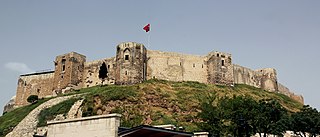
Gaziantep, historically Aintab and still informally calledAntep, is a major city in south-central Turkey. It is the capital of the Gaziantep Province, in the westernmost part of Turkey's Southeastern Anatolia Region and partially in the Mediterranean Region. It is located approximately 185 km (115 mi) east of Adana and 97 km (60 mi) north of Aleppo, Syria and situated on the Sajur River. The city is thought to be located on the site of ancient Antiochia ad Taurum and is near ancient Zeugma.

Malatya is a large city in the Eastern Anatolia region of Turkey and the capital of Malatya Province. The city has been a human settlement for thousands of years.
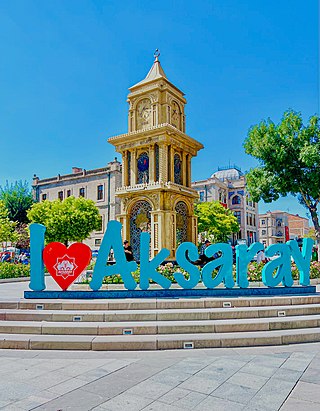
Aksaray is a city in the Central Anatolia region of Turkey. It is the seat of Aksaray Province and Aksaray District. Its population is 247,147 (2021). In 2021 the province had an estimated population of 429,069 distributed over about 7,659 km2 (2,957 sq mi). The average elevation is 980 m (3,215 ft), with the highest point being Mt. Hasan at 3,268 m (10,722 ft).

Adıyaman is a city in southeastern Turkey. It is the administrative centre of Adıyaman Province and Adıyaman District. Its population is 267,131 (2021). The inhabitants of the city are mostly Kurdish.

Merzifon is a town in Amasya Province in the central Black Sea region of Turkey. It is the seat of Merzifon District. Its population is 61,376 (2021). The mayor is Alp Kargı (CHP).

Kilis is a city in southernmost Turkey, near the border with Syria, and the administrative centre of Kilis Province and Kilis District. Its population is 112,187 (2022).

Şebinkarahisar is a town in Giresun Province in the Black Sea region of northeastern Turkey. It is the administrative seat of Şebinkarahisar District. Its population is 10,695 (2022).

The Hatay Archaeology Museum is the archaeology museum of Antakya, Turkey. It is known for its extensive collection of Roman and Byzantine Era mosaics. The museum is located in Antakya, the main city of Hatay. Construction of the museum started in 1934 on the recommendation of the French archaeologist and antiquities inspector Claude M. Prost. It was completed in 1938 and came under Turkish control in 1939 following Hatay's unification with Turkey. The museum was opened to the public in 1948 and re-opened in 1975 following renovation and expansion.

The architecture of Turkey includes heritage from the ancient era of Anatolia to the present day. Significant remains from the Greco-Roman period are located throughout the country. The Byzantine period produced, among other monuments, the celebrated Hagia Sophia in Constantinople. Following the arrival of the Seljuk Turks in the 11th century, Seljuk architecture mixed Islamic architecture with other styles of local architecture in Anatolia. The Ottoman Empire ushered in a centuries-long tradition of Ottoman architecture up until the early 20th century.

The Citadel of Aleppo is a large medieval fortified palace in the centre of the old city of Aleppo, northern Syria. It is considered to be one of the oldest and largest castles in the world. Usage of the Citadel hill dates back at least to the middle of the 3rd millennium BCE. Occupied by many civilizations over time – including the Greeks, Armenians, Romans, Byzantines, Ayyubids, Mamluks and Ottomans – the majority of the construction as it stands today is thought to originate from the Ayyubid period. An extensive conservation work took place in the 2000s CE by the Aga Khan Trust for Culture, in collaboration with Aleppo Archeological Society. Dominating the city, the Citadel is part of the Ancient City of Aleppo, an UNESCO World Heritage Site since 1986 CE. During the 2010s, the Citadel received significant damage during the lengthy Battle of Aleppo. It was reopened to the public in early 2018 CE with repairs to damaged parts underway, though some of the damage will be purposefully preserved as part of the history of the citadel. The citadel was damaged by the 2023 Turkey–Syria earthquake.
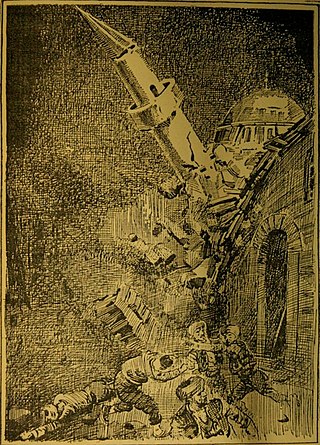
The 1509 Constantinople earthquake or historically Kıyamet-i Sugra occurred in the Sea of Marmara on 10 September 1509 at about 22:00. The earthquake had an estimated magnitude of 7.2 ± 0.3 on the surface-wave magnitude scale. A tsunami and 45 days of aftershocks followed the earthquake. The death toll of this earthquake is poorly known; estimates range between 1,000 and 13,000.

The Skopje Fortress, commonly referred to as Kale, is a historic fortress located in the old town of Skopje, the capital of North Macedonia. It is located in Centar municipality and situated on the highest point in the city overlooking the Vardar River. The fortress is depicted on the coat of arms of Skopje, which in turn is incorporated in the city's flag.

The architecture of Istanbul describes a large mixture of structures which reflect the many influences that have made an indelible mark in all districts of the city. The ancient part of the city is still partially surrounded by the Walls of Constantinople, erected in the 5th century by Emperor Theodosius II to protect the city from invasion. The architecture inside the city proper contains buildings and structures which came from Byzantine, Genoese, Ottoman, and modern Turkish sources. The city has many architecturally significant entities. Throughout its long history, Istanbul has acquired a reputation for being a cultural and ethnic melting pot. As a result, there are many historical mosques, churches, synagogues, palaces, castles and towers to visit in the city.
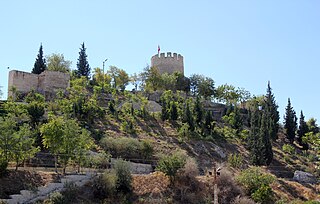
Mut Castle is a castle in Mut, Mersin Province, Turkey.

Şirvani Camii, Şirvani Mehmet Efendi Camii or İki Şerefeli Camii is a mosque in Gaziantep, Turkey.
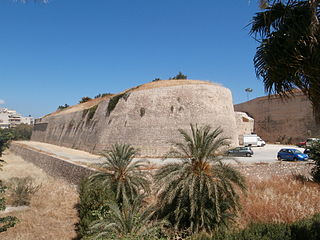
The fortifications of Heraklion are a series of defensive walls and other fortifications which surround the city of Heraklion in Crete, Greece. The first city walls were built in the Middle Ages, but they were completely rebuilt by the Republic of Venice. The fortifications managed to withstand the second longest siege in history for 21 years, before the city fell to the Ottomans in 1669.
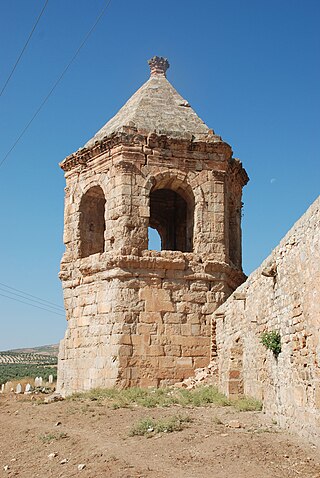
The Mosque of the Prophet Huri or Nebi Huri Mosque is a mosque and mausoleum located at the archeological site of Cyrrhus near Afrin, Syria. It was formerly known as the Nebi Huri Mausoleum as well.


